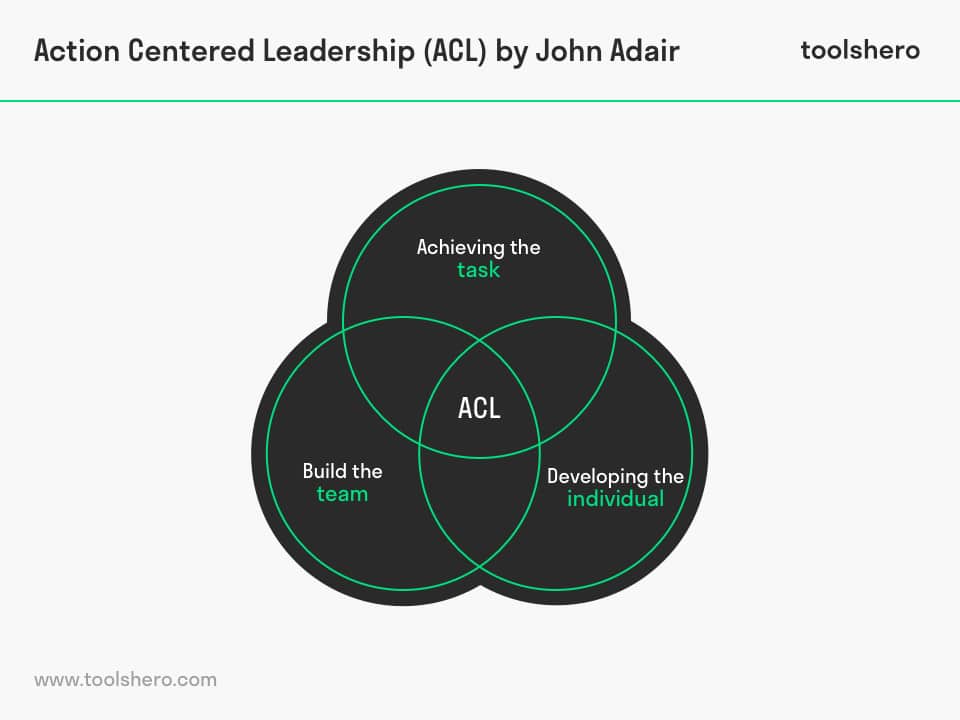Action Centered Leadership Model by John Adair

Action Centered Leadership model: in this article, Action Centered Leadership model by John Adair is practically explained. In addition to what the theory and model are, this article also highlights the three levels of leadership, the overlap of tasks, the team and individual needs and the 8 leadership functions. After reading you will understand the basics of this leadership methodology. Enjoy reading!
What is Action Centered Leadership (ACL)?
British leadership guru John Adair is the inventor of Action Centred Leadership (ACL), which he describes in his book ‘The Skills of Leadership‘. According to John Adair, leadership doesn’t depend on a person’s characteristics, but is something that can be learned.
Additionally, Adair distinguishes between leadership and management. He believes that management is rooted in the organisational system.
Action Centered Leadership : Three Leadership Levels
To work with Action Centered Leadership, it’s important to look at the three different organisational levels that can be distinguished in leadership according to John Adair:
Operational level
Operational leadership, where several team leaders report to one superior.
Team level
Leadership on department level, where it concerns departments of five to 20 people.
Strategic level
Strategic leadership of the entire organisation, where the leader is responsible for all the levels below him.
Additionally, the Action Centered Leadership model is easy to apply and to maintain. Leaders must be able to focus on a few fundamental matters; developing strong teams, increasing productivity, improving the work quality, achieving strong results and building work ethics (the positive attitude employees take towards the work they do).
Action Centered Leadership (ACL) : three Circle Model
In Action Centered Leadership (ACL), Adair defines three overlapping and connected circles. Because leadership is exercised on every level, the task, the team, and the individual within organisations must constantly be taken into account.
After all, employees expect their leaders to help them achieve the joint task, to contribute to the cooperation and synergy of the team or department and concern themselves with the needs of the individual employee. Subsequently, these three circles are interdependent.
The Action Centered Leadership model is independent of the situation or organisational structure. It could help leaders to identify where exactly they lose control over the group or situation.

Figure 1 – the Action Centered Leadership Model (Adair)
1. Task
Tasks must be carried out by employees. Leaders must have insight into the positions and the accompanying tasks, allowing for guidance and supervision. Without tasks, there is no insight into results.
2. Team
Teams are the axis of organisations. Departments have their own speciality. By investing in a good team and by maintaining harmony among the various team members, a leader can create continued coherence. Team spirit leads to productivity and good results.
3. Individual
The leader is responsible for each individual employee, his progress and development. Each individual needs recognition by means of salary, fun and challenging work and responsibility. The leader must have open lines of communication with his employees and monitor their achievements and performance.
Leadership Masterclass – Insights, Models and Application
Action Centered Leadership : Overlap
The Action Centered Leadership model is presented as three overlapping circles. This is also the trademark of Adair’s model. The overlap of the tasks, the team, and the individual needs looks as follows:
Satisfied feeling
Conscientiously completing a task makes an individual employee feel satisfied about his work. Moreover, this increases the team spirit, which benefits the working atmosphere and allows people to help and support each other.
Action Centered Leadership : Safe environment
A properly functioning team offers a safe environment in which individual employees can work comfortably and support each to achieve the best results; this benefits the individual completion of the tasks. The execution of the tasks leads to an excellent result.
Action Centered Leadership : Individual needs
The need of each individual employee is important. When this need is not considered or met, employees are not able and/or motivated to carry out their tasks properly. Consequently, they aren’t open to good contact with the other team members and there will be no team spirit.
Eight Leadership Functions for Action Centered Leadership
According to Adair and his theory of Action Centred Leadership, the above three aspects of leadership can only be successfully fulfilled when the leader sticks to the following eight functions:
1. Defining
Both for the individual employees and for the team (the department itself), it should be clear what tasks and goals they are working on and in what timespan the tasks must be completed.
2. Planning
Following the defining of tasks and goals, it’s important that a clear time plan is included. This means that employees know when a deadline is approaching, but also what is expected of them in the meantime.
3. Briefing
It is the task of a leader to inform his team / department of a team briefing or work meeting, for instance. This open communication creates a good atmosphere and advances collaboration.
4. Control
Leaders shouldn’t just have control over their own performance and functioning, but also make sure they have good control systems at their disposal. For instance, think of effective delegation and monitoring systems.
5. Evaluation
Following controlling, it’s important that leaders are able to evaluate and can evaluate and assess both the team achievements and the individual achievements based on this information.
6. Motivation
No motivated employees without a motivated leader. Adair distinguishes six motivational principles:
- The leader must be motivated himself: be a good role model (see the 8th leadership function)
- The leader must select employees who are highly motivated
- The leader must set realistic and challenging goals (see the 1st leadership function)
- The leader must be aware that progress motivates his employees
- The leader must offer fair rewards that match the performance of the individual employee
- The leader must show recognition towards his employees, by giving compliments, talking to them, showing interest, and granting extra rewards
7. Organisation
It’s the task of the leader to properly organise himself, the team/department, and structures and processes.
8. Example
Following what belongs to the 6th leadership function, it’s important that a leader sets the right example for his employees and his team. Always set a good example.
Action Centered Leadership : Responsibility
The leader is the person who establishes responsibilities, including objectives and measures. This means that, according to Action Centered Leadership, the leader sets the norms and standards and checks and reports on the achievements and progress of the general goal of the team and the individual employee.
With regard to the individual employee, the leader has the responsibility to discuss and evaluate the personal skills and results. In conversations with employees, he’s responsible for asking about the personal needs and to facilitate further development of the employee.
It’s Your Turn
What do you think? Do you recognize the practical explanation or do you have more additions? Is Action Centered Leadership (ACL) applied within your organisation? Do you think leadership can be learned?
Share your experience and knowledge in the comments box below.
More information
- Adair, J. E. (2006). Leadership and motivation: the fifty-fifty rule and the eight key principles of motivating others. Kogan Page Publishers.
- Adair, J. E. (2007). Develop your leadership skills (Vol. 11). Kogan Page Publishers.
- Braun, F. C., Avital, M., & Martz, B. (2012). Action-centered team leadership influences more than performance. Team Performance Management: An International Journal, 18(3/4), 176-195.
- Karve, S. (2023). Leadership Masterclass – Insights, Models and Application. Retrieved 07/02/2024 from Udemy.
How to cite this article:
Mulder, P. (2019). Action Centered Leadership (Adair). Retrieved [insert date] from Toolshero: https://www.toolshero.com/leadership/action-centered-leadership-acl/
Original publication date: 05/04/2019 | Last update: 02/07/2024
Add a link to this page on your website:
<a href=”https://www.toolshero.com/leadership/action-centered-leadership-acl/”>Toolshero: Action Centered Leadership (Adair)</a>












